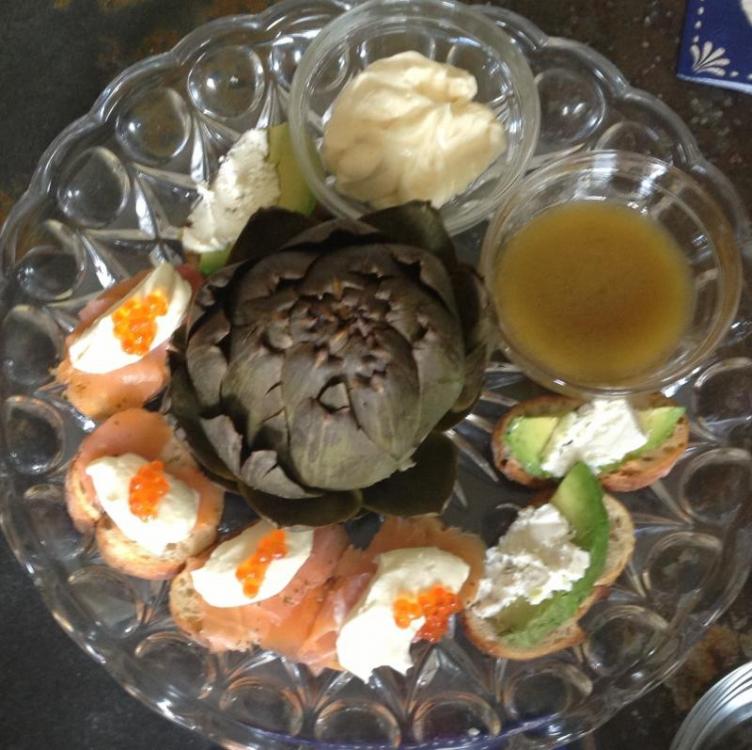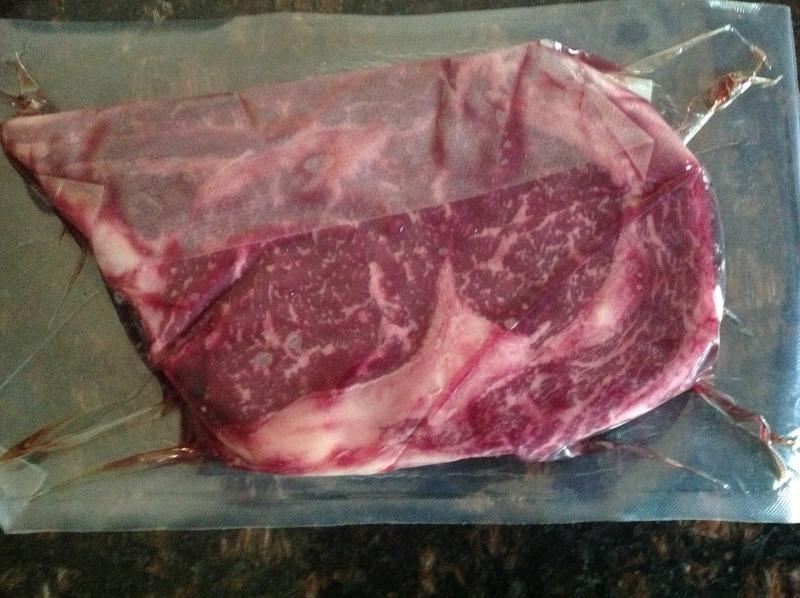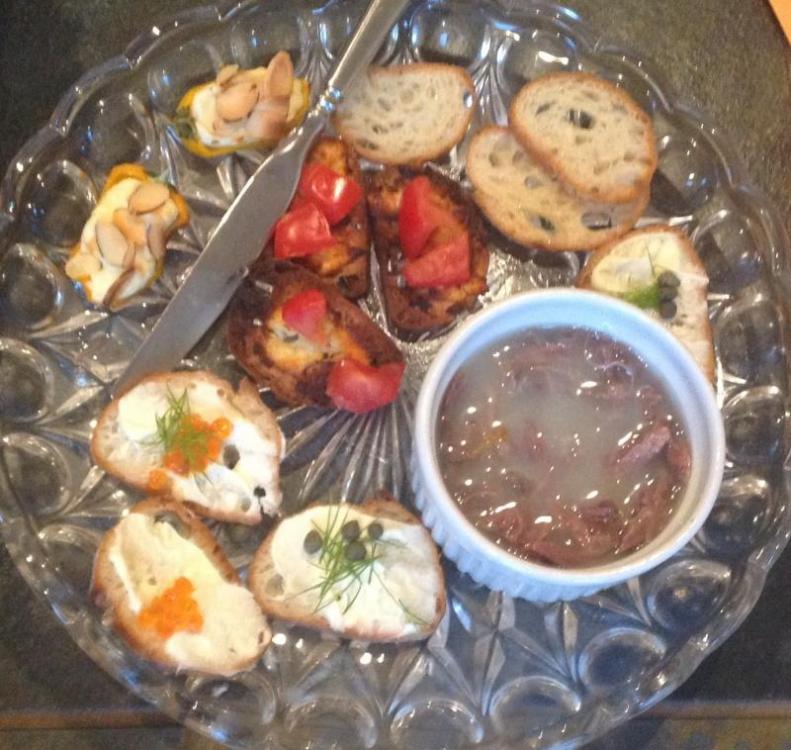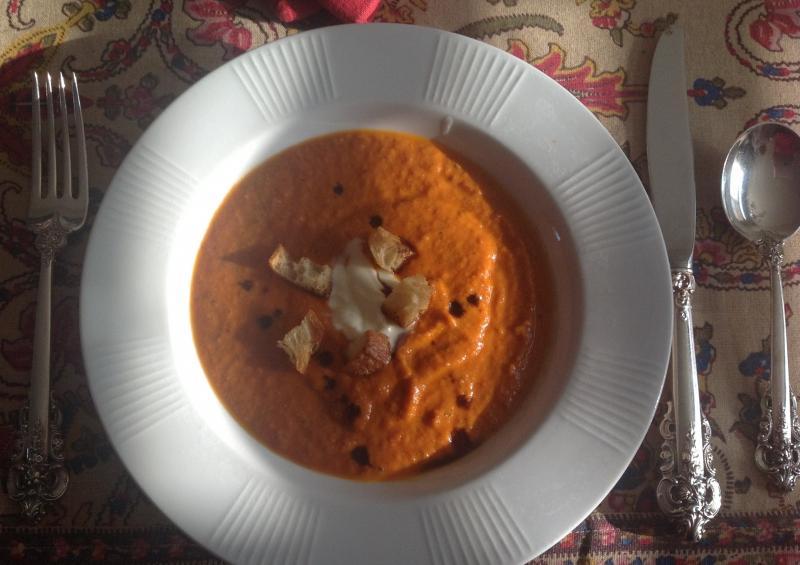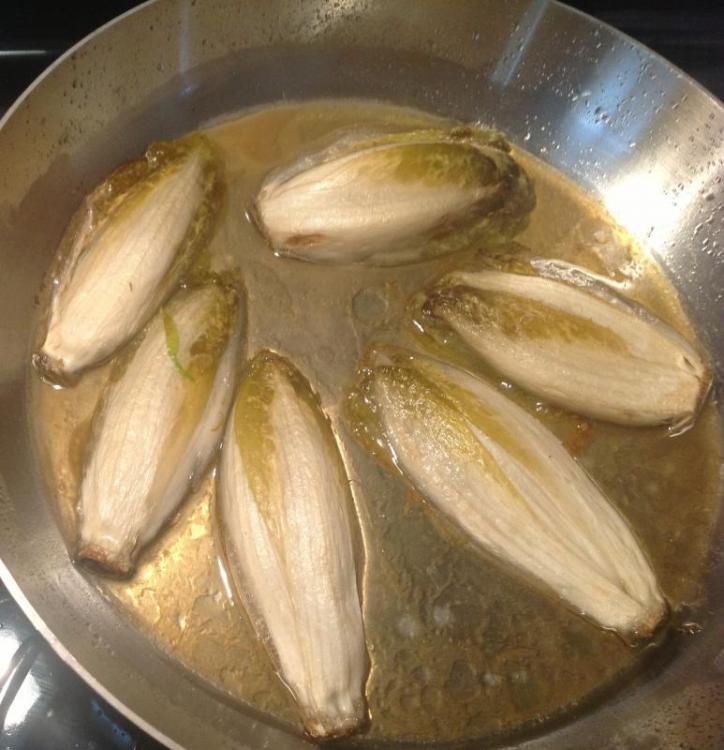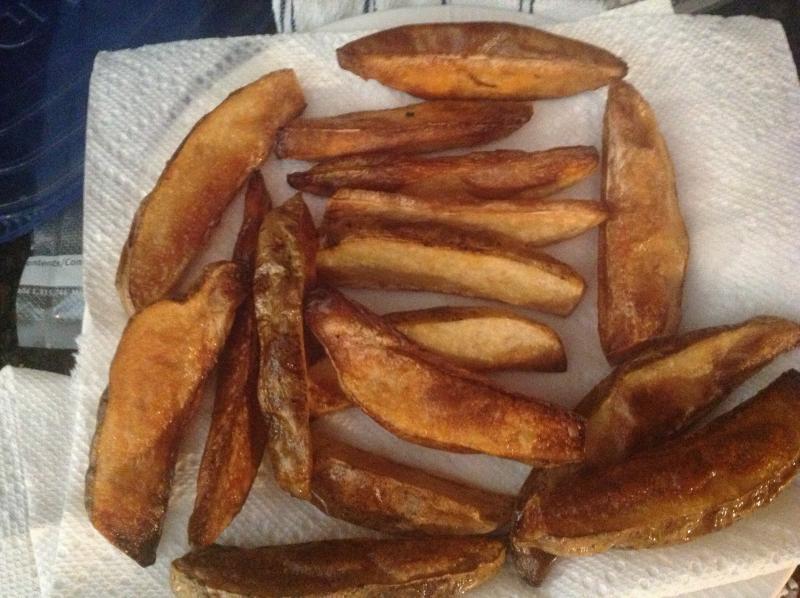
furzzy
participating member-
Posts
176 -
Joined
-
Last visited
Content Type
Profiles
Forums
Store
Help Articles
Everything posted by furzzy
-
New Sainsaire $199 Sous Vide circulator on Kickstarter
furzzy replied to a topic in Kitchen Consumer
Thanks so much for this! I'd found something about it from a Twitter/Tweet - whatever - but the linked site had nowhere to subscribe or donate/pledge. Now I'm in on this! -
Hey Anna! Don't know how I missed this on the other thread, but I'm glad you re-posted it here. I'm definitely going to be making this!
-
Ethnic foods I'm supposed to like - but don't.
furzzy replied to a topic in Food Traditions & Culture
You got it! -
You are welcome furzzy. I hope you let me and others know of your opinion on proper double searing. If done correctly, the flavors are very deep/robust. And safer for long cooks aswell.Help me out with "proper double searing" to give me a head start. How much on the first sear? I'll probably not SV, so how much if any) of the actual cooking goes with the first sear? Then is the second sear mainly for adding the depth & warming it up? I'd like to start this with the knowledge you've already accumulated, rather than re-inventing the wheel. The more I think about it, the more I'm getting into this idea.
-
Anne_T The gratin in the cast iron skillet looks delightful. Thanks for sharing the method! Panaderia Canadiense Going to let my ignorance hang out here. Question about "spring lamb" - I've only been able ever to get "spring" lamb in the spring, mostly mid-spring. Also, since we like domestic lamb far better than that sourced from Aussie/New Zealand, my guess has been that the lambing takes place in Feb/Mar - & maybe Apr - and I'm looking for 6-8 wk lamb, never frozen. I just ordered a rack from D'Artagnan, fresh. I'm eager to hear your input - on anyone's.Please be kind enough to disabuse me of anything where I'm wrong. I'll point out for starters that I live in Ecuador, and that our seasons are a bit different. It's currently spring (or rather it's a spring-esque lambing season in Salasaka, where the lamb in question came from) and hence what I ate was spring lamb. The neat thing about this country, though, is that when it's no longer "spring" in my province, it will be "spring" in neighbouring Bolívar or in another close province. This boils down to spring lambs, milk fed and between 6 and 8 weeks old, being available here almost year round.... It's a unique advantage to living this close to the equator and at such a high altitude. I also suspect that many of the breeds found in the highlands close to my markets are year-round rather than seasonal breeders (whereas in Canada at least the seasonal breeders are more common), which means that here in Ecuador not only do I get the rather abundant and delicious spring lambs (and my butcher is very precise about what she calls the lamb she sells) but also very tender and tasty milk lambs in the non-spring seasons. Up in the nothern hemisphere, spring lambs are born either in late winter or early spring (so February-April or so) and must be sold before July 1 to qualify. Anything else between 6 and 8 weeks but born in a different lambing season is milk lamb, which is very similar in flavour and texture, although in my experience milk lambs tend to be just a tad stronger tasting than spring ones. Thanks so much for this explanation. I've never had lamb sourced from anywhere but either New Zealand/Australia or the Domestic US lamb raised in Colorado. I had no idea Ecuador produced lamb.We had a rack of lamb done on the Big Green Egg last evening - best we've ever had! Veggies also done on the BGE, except for the potato spears fried in duck fat! ETA duck fried potato spears
-
I tend to do the same two dips for my artichokes - home made aioli and champagne vinaigrette. Now I'm going to have to try some of things mentioned in this thread. I don't know why it never occurred to me to do the artichoke(s) in the pressure cooker! We happened to have them with hors d'oeuvres last evening: The canapés are crisp crostini with Avocado & Cypress Grove Purple Haze Goat Cheese, and Charlie Trotter's Citrus Smoked Salmon & Creme Fraiche & Salmon Roe. Question: What do you all do with the lovely artichoke bottoms that are left over?
-
Paul Bacino - While you said you've never actually had the Grade 12 Miyazaki, have you any idea where to source it? I read that entire article & followed some of the links, but nothing took me to any actual source for it.
-
Yes, Capelin is a type of Smelt, but from Canaa, Newfoundland, etc. - prepare it the same way as smelt - fry it whole (bones, heads, evrything) after salting & a light dusting of flour mixed with a little cornstarch - OR better yet, a tempura batter made with sparkling water. The season here (Chicago) is technically April. At least that's when individuals can seine for them. But my fishmonger carries them through May, at least. We eat lots of them when they're available. Oh, YUM!
-
To the "naysayers" concerning oil on troubled waters: I should have explained further, I guess. Never occured to me it wouldn't be universally understood. My bad. I'm a sailor, of sorts. USCG 400 Ton Master with Ocean Routes Endorsement, certified by Lloyds London to skipper sailing vessels worldwide. I did a lot of deliveries - and my husband & I cruised & lived aboard our 35' sailboat for 13 years. (Maybe we should have a topic about cooking in Small spaces <G>) When the weather whips up seriously, and even heaving to isn't quite enough, pouring a little oil onto the water Does calm the seas to a great extent. When it's too bad to go upwind at all, and one must "run before the storm" (meaning head downwind), towing a line with a canvas bag filled with oil can make the difference between surviving or being "pitchpoled" (meaning flipped end over end - deadly), or even being "pooped" - (waves coming over the vessel from behind). It DOES work. The has been described all the way back to Pliny - & Benjamin Franklin did some experiments with it. I was able to find some information aboout that "research" online. http://www.benfranklin300.org/_etc_pdf/Dutch_Joost_Mertens.pdf This short quote comes from an article actually addressing the BP oil spill in the Gulf of Mexico, but goes into the subject of oil on water. There's a short video about halfway down the page that's interesting to watch. Find this at: http://deepseanews.com/2010/06/pouring-oil-on-troubled-waters/ I used oil with very satisfactory results during the late severe hurricane of the 25th of August, in latitude 31 N., longitude 790 W. The wind having carried away the mainsail, I bent a storm trysail, and continued under that sail until it also blew away. During the time, the vessel was shipping large quantities of water, the sea being very irregular, nearly every one breaking. After the sails were blown away, finding it necessary to do something to save the ship and crew, I took a small canvas bag and turned about five gallons of linseed oil into it, and hung it over the star- board quarter. The wash of the sea caused a little of the oil to leak out, and smoothed the surface, so that for ten hours no water broke aboard. I consider that the oil used, during the last and heaviest part of the hurricane, saved vessel and crew. Hope this helps, if anyone is actually interested, to understand why putting a bit of oil on the roiling pasta water keeps it from boiling over (usually).
-
Important to always keep in mind! Very interesting information. I've looked over their entire site; unfortunately, they don't ship to consumers. I've a Wagu bone-in Rib-eye from D'Artagnan in the fridge. Would love to order another of those & obtain one for Nikuya and compare. I may call their sales line & see where I might obtain one. If I am able to do so, I'll report back. Here's the one I have - the marbling wasn't quite what I expected, and certainly doesn't match the high end from that scale. First one I've ordered from D'Artagnan, so will have to check out the flavor, etc. Thus far, the appearance definitely doesn't beat the Prime rib-eyes that we buy from Fox & Obel in Chicago - not even sure it beats the Choice.
-
IMHO, your experiences are spot on re: food safety. Don't know when I'll have a chance, but I'm going to keep in mind your double searing technique. So many times it's nice to put up dinner as much as possible early in the day to minimize the chaos "a la minute" in the evening. This has been avery interesting topic - thanks for bringing it up.
-
Very interesting...I didn't catch the double sear from your first post. I can see that the double sear could ramp up the flavor.
-
According to Sanitization classes in school, There's a roughly 4 hr (total) window of safety inside the "danger zone" of 40-140 F I've done what you do for years & years & years - not even cooling in an ice bath, just giving it some time to cool on the counter until it's okay to go into the 'fridge without heating it up. In addition to that experience, I lived on a 35' sailboat for 10 yrs. & found that most refrigeration paranoia these days is just that: paranoia. Example: when provisioning, I'd buy small jars of things like mayo. Once opened, it would stay on the shelf in the tropics until used (I rarely made mayo on the boat - eggs too precious). That might be a couple of weeks - Never had one go bad. My (long term) experience is that you are not dodging any bullets with what you're doing. But I'm curious....why do you sear/par-cook first & then SV, rather than vice verrsa?
-
My very favorite "6-Week Bran Muffins" use Kellog's 2 Scoops! Tried other kinds & they just don't work.
-
There have been references to Souther Style green beans - but no one has told how to do it. We call them "cooked down" green beans. Dice & cook up a few pieces of bacon. (Start w/some water in the pan & when it's gone the bacon will crisp without going black. Remove to drain on paper towels. Sweat a great big diced onion in the rendered bacon fat. I usually use yellow onions, but whatever you prefer is fine. Make sure they're really translucent & soft, but not browned. Throw in the green beans - I like to leave them tipped but whole. Try it that way, and then next time cut them if you think you'd like that. Add some chicken stock (since this is kind of a braise, enough to come about half-way up the beans), a pinch of baking soda to keep the color, S & P. This is where you can add any spices or herbs, but I usually don't - I prefer without). Cook, covered, over low/med-low heat, checking liquid level. Add more chicken stock as needed. When they're soft & kinda' limp, but Not mushy, they're done. When you stir, a few of them will have started to split and some seeds come out - not a lot, just a few. Add the bacon back in & stir in down into the broth so soften just a tiny bit. Just be warned, you need to make at least twice the amount you think you'll need.
-
Ethnic foods I'm supposed to like - but don't.
furzzy replied to a topic in Food Traditions & Culture
There has to be an aversion to the word going on. I'm not trying to convince you to like curries but there are so many different curries that have so many different flavor profiles and textures from different parts of the world that there is no possible way they could be lumped into one dislike category. You're absolutely right. What I should have said is that though I've had many, many curries, I've never had one I liked. By now, I just "pass" on curry. There's an undercurrent I can't place that I just don't like. I could add: cilantro. I tried & tried to learn to eat cilantro, and then finally heard about that gene that makes one either love or hate cilantro. Whether that's true or not, it relieved my guilt about hating cilantro. ;o) -
Ethnic foods I'm supposed to like - but don't.
furzzy replied to a topic in Food Traditions & Culture
curry - all curries -
Two things: Taking the pasta directly from the water to the sauce is the way to go, as several have said. Putting oil into the cooking water for pasta has nothing to do with the pasta at all. It's only to keep the pot from boiling over (you've heard of "spreading oil onto troubled waters?" That's what it's about.
-
The springform pan should be put on a big sheet of aluminum foil & the foil wrapped up around the pan. The the springform pan put into a roasting pan, & water poured to at least half way up the side (closer to 3/4 of the way is best.) Then bake at 325 for roughly an hour. Test for doneness by inserting an instant-read thermometer half way between the center & the circumference - 180 - 190 F is about right.
-
I'm confused about using the PC for the "low & slow" things. Since the PC brings up the pressure & therefore the temp... Of course, I know it works for stocks... But I'm confused. ??
-
I have not found Cajun food to be particularly "hot spicy" though pepper sauces are always on the table for individual adjustment and add-ins. Here is a snippet from an interview with Chef John Folse giving a a good explanation:"Cajun food is always seasoned, but not always hot and spicy. Spicy insinuates that the food is highly flavored with peppers such as cayenne, Tabasco, etc. However, highly seasoned, which Cajun cooking certainly is, refers to flavor in our food: onions, celery, bell pepper, garlic, green onions, parsley and even herbs, such as basil, thyme, tarragon and rosemary. "Very interesting. Thanks for the clarification. I'd always thought of Cajun as hot/spicy.
-
Dejah - how creative! And it looks very tasty (though I couldn't do an egg White omelet...gotta have the yolks.) ;o)
-
I hang my head in embarrassment. I've no pictures of the beef! But here's the "aperitif" plate And the soup (home made roasted tomato soup garnished w/creme fraiche, croutons, & 18-yr Balsamic And the braised Belgian Endives And the Idaho Potato Spears sauteed in Duck Fat I went retro with the beef. Heated the "demi-glace" from before & added some beef stock to thin it out & add even another layer of flavor. Reduced that a bit. Just before serving that course, brought the sauce back up to temp & put the beef into it, just long enough to warm it a bit. Didn't worry about making it "hot." Then served the sauce in a boat for "extras" for those who wanted it. It all turned out to be perfect, except we still had leftover beef. so I picked up on the suggestions from here & had fajitas, which finally finished it up! Thank you all for your input - and I'm so sorry about no pics. I had to go up to bed, and nobody thought of it.
-
I buy the big clam shells of Spring Mix for salads, then saute then with pine nuts & raisins that have been soaked in sherry.



